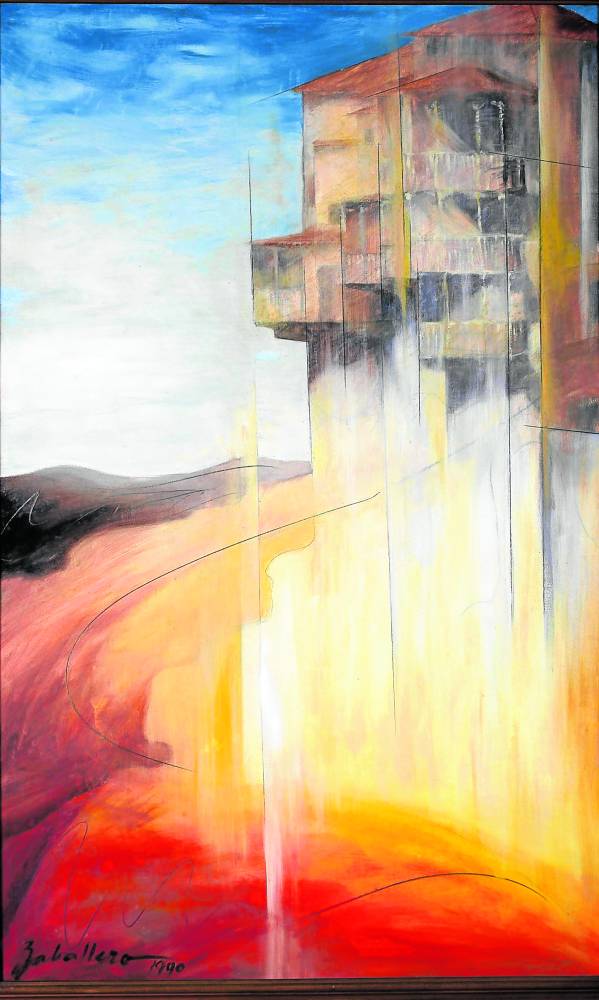The painter Phyllis Zaballero (Rosario, Cavite, 1942) is one of the most outstanding artists, representative of contemporary Filipino painters. Having spent her adolescence and youth in different countries—the United States, Switzerland, France and Spain—resulted in her cultured and cosmopolitan personality. The years she spent in Barcelona (1957-1960) had a strong impact on her paintings afterward. A series of works captured on canvas the memories of her trips around the Iberian Peninsula.
Instituto Cervantes de Manila started with the exhibit “Creadoras,” a series dedicated to Spanish artists who have put down roots in the Philippines, such as Betsy Westendorp, and continued with Filipino artists who have had a special link with Spain and Hispano-America. Until Jan. 22, 2023, the exhibit room of Instituto Cervantes in Intramuros will hold a selection of Zaballero’s “Spanish paintings,” which come from different private collections, including the artist’s.
Postmodern generation
Zaballero belongs to what we can define as the postmodern generation, trained in the spirit of the still revolutionary avant-garde style of the first half of the 20th century. She has very interesting abstract works.
Her training and her first artworks were developed in an extraordinary period of Philippine painting, from the ’50s to the ’80s, together with artists such as Fernando Zóbel, José Joya, Arturo Luz, Hernando Ocampo, Cesar Legaspi, Ang Kiukok and Pacita Abad.
The years she spent in America and Europe had much to do in her artistic career that is more cosmopolitan than other Filipino painters like Manansala, Magsaysay and her contemporary, Ben Cabrera, who were heavily influenced by local themes and issues. Her training years at the University of the Philippines, with maestros such as Chabet, Joya and Abueva, also inevitably took her through the path of abstract modernity.

Phyllis Zaballero’s “Casas Colgadas de Cuenca”
She has a very interesting abstract piece that is worth highlighting, “Windward I” (1978), a painting more than 70 feet long, which was shown in her first exhibit at the Cultural Center of the Philippines. There is also the “Gulianas” series, as well as other artworks in which the North American abstract expressionism of the ’50s—Pollock, mainly—is an unavoidable reference.
Deep crisis
The abstraction-figuration dialogue is a constant theme in the paintings of the last two centuries. The violent death of Ninoy Aquino in 1983 and the premature death of a very close friend, Jaime Ongpin, provoked a deep crisis in Zaballero, a consequence of which is the appearance of figures in her paintings. In this sense, “Jimmy’s World” (1988) marks a turning point in her career, as well as the still rather abstract “August 21” (1983) as a precedent. The affirmation of this change will be depicted in “Arcos de la Frontera I, David” (1990).
And this is where the turn to postmodernism happens, in which some narratives in Zaballero’s paintings appear, which were absent in her first stage. Abstraction will still be very present in her paintings until the turn of the century, not as an object in itself but rather in the service of a narrative, that of the landscapes in Cuenca, Provence and Alaska.
A major milestone in the evolution of Zaballero’s career is “Etude Pour Une Fête” (1998), a very elongated painting with a ratio of about 5:1—and which marks all the elements that will become her characteristic language in the last 25 years, the one by which her work will be identified by the posterity. Having practiced the language of the avant-garde, of cubism or abstract expressionism, Zaballero turns her gaze to those masters who have made an impact on her during her adolescence, Cezanne and Matisse.
This is a very postmodern shift, but very special. Postmodernism is identified as a return, or a look to the classical world. It is what we have seen in Spain during that era, with the paintings of Pérez Villalta or Carlos Forns, just to give a couple of examples of the “New Madrid figuration” in the ’70s and ’80s. Short but intense
The relationship of Zaballero with Spain has been short but very intense. In Barcelona, her painting vocation began, at the age of 18, and was halted for a long time until after she got married and had three children.
At 32, she began to study art at the University of the Philippines. The streets of Barcelona, its markets and restaurants; the landscapes of Andalucía; the Cuenca of Fernándo Zobel—all had a profound impact on her, as she took them to the canvas 30 years after these places caught her eye. These images, taken from her own memory, are the ones presented in this exhibit.
Zaballero carries out her career in a rational way. Her solid university training, her degree in economics aside from fine arts, bring her to carry out her projects in a methodical order, which includes documentation and cataloguing. This rationality is very present in her abstract and figurative art, with geometric networks that reach a metaphysical dimension in her “ventanas,” the protagonists of domestic landscapes in which there is no human presence, but it can be felt.
Her intellectual curiosity is channeled in her writings; her ethical values take her to be a militant activist in the causes that she defends. Phyllis Zaballero embodies the figure of an artist whose vitality is not just a source of artistic creation, but also a motor to live a full private and civic life.
The author is the director of Instituto Cervantes Manila. The exhibit devoted to Zaballero’s Spanish paintings at the Instituto’s Intramuros premises happens almost at the same time that an exhibit of Fernando Zóbel works will be displayed at El Prado Museum in Madrid, and some months after the closing of National Artist for Visual Arts Kidlat Tahimik’s exhibit in El Retiro de Madrid. These are, he notes, “good times for interchanges between Spain and the Philippines in the art world.” —Contributed INQ